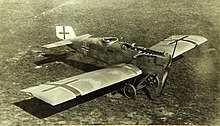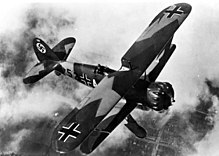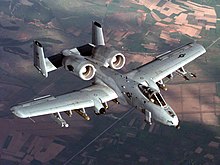Ground attack aircraft

A ground attack aircraft , also ground attack aircraft or attack aircraft , is a combat aircraft that is specially designed for close air support to one's own troops.
Since the attacks mostly take place at low altitudes and strong defensive fire can be expected, ground attack aircraft are often heavily armored . Their range and bomb load are low compared to tactical bombers, but they are often suitable for use on airfields close to the front, with little development and can therefore react quickly to requests for close air support and, if necessary, take off several times a day. In addition to a moderate bomb load, the armament often consists of large-caliber automatic cannons , unguided and guided air-to - surface missiles . Outstanding flight services are usually not provided for reasons of cost.
history
First World War
The ancestors of ground attack aircraft were two-seat fighter aircraft , in the First World War with machine guns and light bombs , hand grenades and flechettes fighting low flying enemy ground troops. Their use has been a typical means of supporting infantry attacks since 1917 at the latest.
In the German Army there were special "Fliegerstaffeln, Infantry" or " Infantry pilots " to support the infantry . Their task, however, was more in the area of reconnaissance and liaison and only secondary in the fight against ground targets. Since 1916 there were also "Schutzstaffeln" for the protection of the reconnaissance pilots. These have already been used frequently for attacks on ground targets, especially through the initiative of individual pilots and squadron leaders. These units were budgeted from 1917, were given the designation "battle pilot squadrons" and were grouped together in "battle pilot squadrons". A new “technical weapon system” emerged, which played a role especially in the attack battles of spring and summer 1918. As part of the air force categorization system , they were given mainly aircraft with the code CL, later J. Initially, the pilots preferred light, flexible designs. Due to the increasing losses due to ground fire, however, in 1917 there was a transition to heavily armored models such as the Junkers JI , AEG JI and finally the lighter Junkers J10 .
Between the wars and the Second World War
This idea was pursued in the Soviet Union . As early as the 1920s, types R-1 , R-3 and R-5, which were temporarily converted to ground attack aircraft, were used to practice interaction with ground troops and became the predominant doctrine of the Red Army . Since the types used were only temporary solutions, the construction of special types was commissioned from the beginning of the 1930s, which were divided into the categories light (LSch), heavy (TSch) and heavy armored attack aircraft (TSchB). The first two classes were only lightly armored and were intended to be used for brief surprise attacks. After several built and tested models, however, these types were abandoned and the heavily armored attack aircraft, which was supposed to provide massive support for the ground troops on the battlefield as "flying artillery", was given priority. At the end of the 1930s, several attack aircraft types were under development, of which the Su-6 and Il-2 went into series production. Since the latter, with its strong armor and good low-level flight characteristics, proved to be superior, the Il-2 became one of the most frequently built aircraft of the Second World War with around 36,000 units .
In the course of arming the Wehrmacht , the idea of the ground attack aircraft was also taken up in Germany and a small number of Henschel Hs 123 were procured , which were later reactivated during the war. In the following, however , the Air Force primarily pursued the Ju 87 dive bomber , which was designed primarily for interlocking tasks, but could also provide air support on the battlefield. An attack aircraft has been developed with little emphasis since 1937 and produced in small numbers with the Hs 129 . With a 30-mm MK 103 cannon or a 75-mm anti- tank gun , it proved above all to be a successful tank destroyer.
Allegedly, the Ju 87 G was also very successful in this field with two 37 mm Flak 18 under the wings. With this "cannon bird" Hans-Ulrich Rudel achieved a considerable number of tank shots that are not considered safe today. All of these types of aircraft were found to be very endangered by enemy fighters. From 1941 the Hs 123 was only used on the Eastern Front. The Luftwaffe was forced to increasingly use fighter-bombers such as the Focke-Wulf Fw 190 of the F series . The Western Allies also embarked on this path very successfully (e.g. Hawker Typhoon ). Towards the end of the war, cluster bombs (e.g. the German SD 4 HL ), yellow incendiary bombs ( napalm ) and on-board missiles of various calibres were increasingly used.
Post-war until today
Vietnam War
During the Vietnam War it quickly became apparent that modern jet fighter jets were unsuitable for the role of close air support in an asymmetric war due to their size, complexity and comparatively high costs. That is why the USA and the South Vietnamese used the outdated piston engine-powered Douglas A-1 "Skyraider" on a larger scale for close air support, which initially proved its worth thanks to its high weapon load and length of stay in the target area. She was supported in this role by the Cessna A-37 and the North American OV-10 "Bronco". For the role of night warplanes, the so-called gunships were derived from transport aircraft of different sizes. In addition, the first combat helicopters were developed for this role.
After the Vietnam War
Based on experiences from the Vietnam War , in particular with regard to the effectiveness of the anti-aircraft fire, the armored ground attack aircraft A-10 ("Warthog") was created in the United States, which should be able to provide ground troops with immediate close air support even under strong resistance. The Soviet Union procured the Su-25 , which is smaller and less demanding than the A-10, but with its good armor and armament it can be considered a full-fledged ground attack aircraft. Both models were used in Afghanistan , the A-10 also in the Gulf Wars and the Kosovo War .
The European countries rely on small, inexpensive ground attack aircraft based on common training aircraft , Germany and France procured z. B. the Alpha Jet , Great Britain the BAE Hawk , Italy developed the AMX together with Brazil . In Argentina, the FMA IA 58 Pucará was developed, a light twin-engine turboprop aircraft that was used in the Falklands War .
The ground attack aircraft lost its importance as the attack helicopter demonstrated its survivability and greater maneuverability in action. Modern combat aircraft are increasingly multi-purpose combat aircraft , which also effectively cover the field of close air support. With the reduction in air forces after the end of the Cold War , it was therefore often uneconomical, even for larger armed forces, to maintain models with a range of operations that was strictly limited to close air support.
Even so, recent conflicts have shown the value of this type of fighter jet. The United States, for example, wants to keep its A-10 fleet in service until at least 2028 and has given its aircraft a complex overhaul from 2007 to 2011. Russia has sold the Su-25 to over 13 countries and developed it into the Su-39 . Some states also use turboprop models specifically for use in asymmetric conflicts . B. the Brazilian Embraer EMB 314 is used. Compared to helicopters, they have the advantage of lower costs, greater cruising speed, and greater range and length of stay in the combat zone.
See also
literature
- D. Herwig, H. Rode: Secret projects of the air force. Volume III: Attack aircraft and combat destroyers 1935–1946. Motorbuch-Verlag, Stuttgart 2002, ISBN 3-613-02242-7 .
- Donald, David, Daniel J. March (Eds.): “A-10 Fighting Warthog”. Modern Battlefield Warplanes. AIRtime, Norwalk, (Connecticut) 2004, ISBN 1-880588-76-5 .
- Lou Drendel: A-10 Warthog in action. Squadron / Signal Publications, Carrollton, Texas 1981, ISBN 0-89747-122-9 .
- The Fairchild Can-Opener: Shturmovik of the Eighties? In: Air International. Vol. 16, No. June 6, 1979, pp. 267-272, 287. Bromley, UK: Pilot Press. ISSN 0306-5634 .
- Kurt Möser, Attack Pilot 1918 - A Technical Weapon System in Context. In: Technikgeschichte 77 (2010), pp. 185–230
- Wolfgang Wagner: Hugo Junkers aviation pioneer - his aircraft. (= German aviation. Vol. 24). Bernard & Graefe, Munich et al. 1996, ISBN 3-7637-6112-8 .
- Martin Pegg: Hs 129. Panzerjäger! Classic Publishing, Burgess 1997, ISBN 0-9526867-1-6 . (English)
Web links
Individual evidence
- ↑ Kurt Möser, Attack Airmen 1918 - A Technical Weapon System in Context. In: Technikgeschichte 77 (2010), pp. 185–230
- ↑ Wilfried Copenhagen: Encyclopedia Soviet aviation. Elbe-Dnjepr Verlag, Klitzschen 2007, ISBN 978-3-933395-90-0 , pp. 238–243 (sections attack aircraft forces and attack aircraft ).









